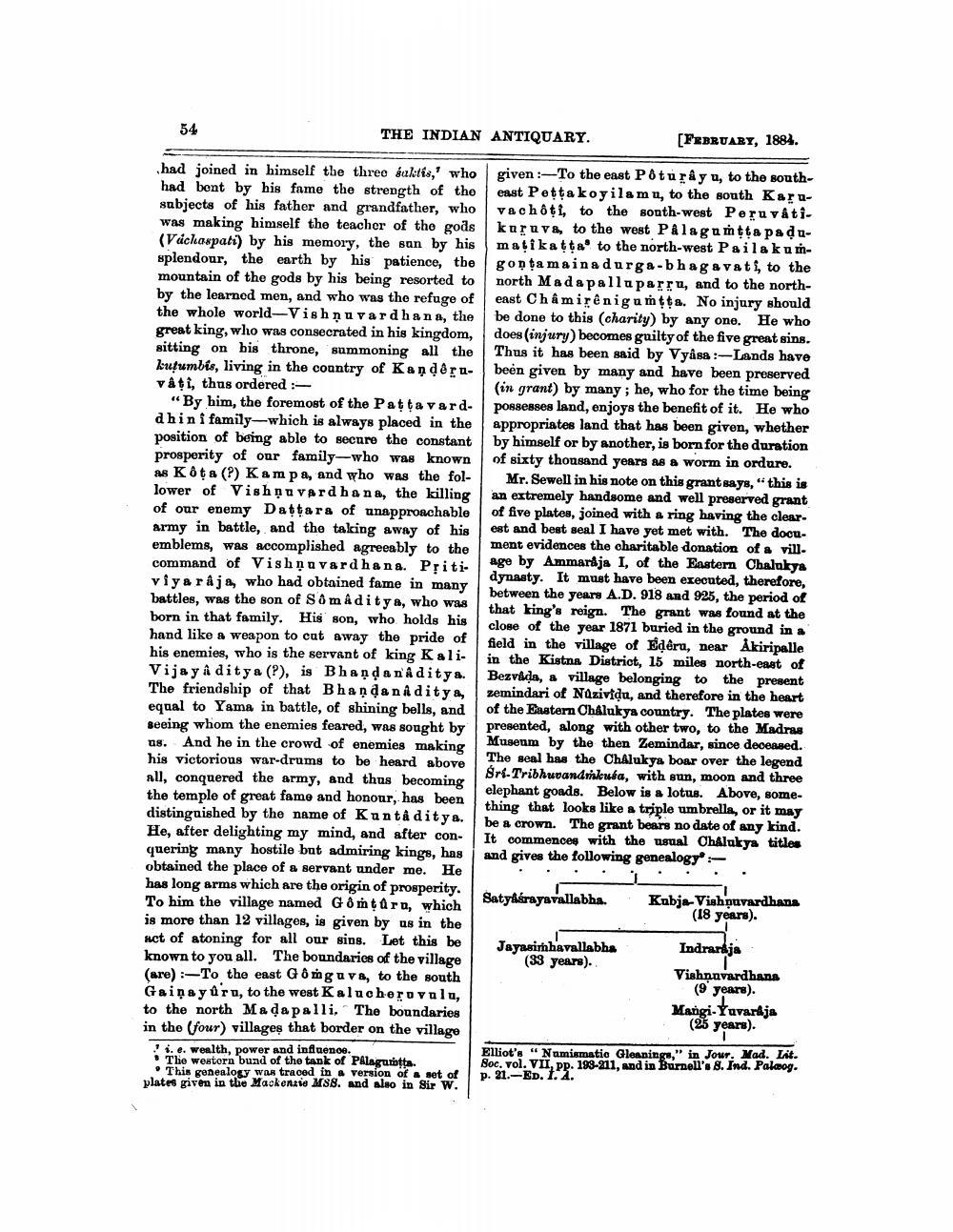________________
54
THE INDIAN ANTIQUARY.
[FEBRUARY, 1884.
had joined in himself the three saktís,' who had bent by his fame the strength of the subjects of his father and grandfather, who was making himself the teacher of the gods (Váchaspati) by his memory, the sun by his splendour, the earth by his patience, the mountain of the gods by his being resorted to by the learned men, and who was the refuge of the whole world-Vishnuvardhana, the great king, who was consecrated in his kingdom, sitting on his throne, summoning all the kutumbis, living in the country of Kandern- vâti, thus ordered :
“By him, the foremost of the Pattavard. dhin i family-which is always placed in the position of being able to secure the constant prosperity of our family-who was known as Koļa (?) Kampa, and who was the follower of Vishnuvardhana, the killing of our enemy Dattara of unapproachable army in battle, and the taking away of his emblems, was accomplished agreeably to the command of Vishnuvardhana. Pritiviya râjs, who had obtained fame in many battles, was the son of Sômaditya, who was born in that family. His son, who holds his hand like a weapon to cat away the pride of his enemies, who is the servant of king Kali Vijay â ditya (?), is Bhanda nå ditya. The friendship of that Bhandaniditya, equal to Yama in battle, of shining bells, and seeing whom the enemies feared, was sought by as. And he in the crowd of enemies making his victorious war-drums to be heard above all, conquered the army, and thus becoming the temple of great fame and honour, has been distinguished by the name of Kuntêditya. He, after delighting my mind, and after conquering many hostile but admiring kings, has obtained the place of a servant under me. He has long arms which are the origin of prosperity. To him the village named Gôm tard, which is more than 12 villages, is given by us in the sct of atoning for all our sins. Let this be known to you all. The boundaries of the village (are) :-To the east Gômguva, to the south Gaiņa yurs, to the west Kalucherovulu, to the north Madapalli. The boundaries in the (four) villages that border on the village
1. e. wenlth, power and influence.
The wentorn bund of the tank of Palagutta. • This genealogy was traced in & version of a set of plates given in the Mackenzie M88. and also in Sir W.
given :-To the east Pôturayu, to the southeast Petta koyilam, to the south Karuvac hôti, to the sonth-west Peru vâtikaruva, to the west På lagunţta padumatikatta' to the north-west Pailaku mgo tamaina durg&-bhagavat, to the north Mada palla parru, and to the northenst Châ mirênig umta. No injury should be done to this charity) by any one. He who does (injury) becomes guilty of the five great sins. Thus it has been said by Vyasa :-Lands have been given by many and have been preserved (in grant) by many; he, who for the time being possesses land, enjoys the benefit of it. He who appropriates land that has been given, whether by himself or by another, is born for the duration of sixty thousand years as a worm in ordure.
Mr. Sewell in his note on this grant says, "this is an extremely handsome and well preserved grant of five plates, joined with a ring having the clear. est and best seal I have yet met with. The document evidences the charitable donation of a vill. age by Ammardja I, of the Eastern Chalukya dynasty. It must have been executed, therefore, between the years A.D. 918 and 925, the period of that king's reign. The grant was found at the close of the year 1871 buried in the ground in a field in the village of Edêru, near Åkiripalle in the Kistna District, 15 miles north-east of Bezvada, a village belonging to the present zemindari of Nazividu, and therefore in the heart of the Eastern Chalukya country. The plates were presented, along with other two, to the Madras Museum by the then Zemindar, since deceased. The seal has the ChAlukya boar over the legend Sri-Tribhuvandíkuea, with sun, moon and three elephant goads. Below is a lotus. Above, something that looks like a triple umbrella, or it may be a crown. The grant bears no date of any kind. It commences with the usual Chalukya titles and gives the following genealogy" :
Satykiśrayavallabha.
Kabja-Vishộuvardhana
(18 years).
Jayasinhavallabha
(33 years).
Indraraja Vishnuvardhana
(9 years). Mangi-Yavardja
(25 years).
Elliot's "Numismatic Gleanings," in Jour. Mad. Lit. Soc. vol. VII, pp. 193-211, and in Burnell's 8. Ind. Pakoog.
Pp. 193-31 Glonningu,
p. 21. AK
Lo in sir




